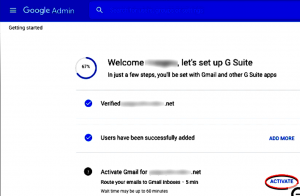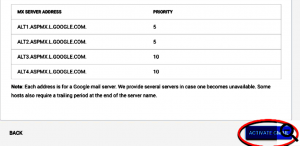Use MX records to verify your domain (if you haven’t already verified it) and to set up Gmail as your professional email.
After you’ve switched to Google’s MX records, you can get your email in your Gmail inbox or through an email client like Microsoft Outlook.
How it works
- Keep setup instructions open and sign in to your domain host in another window or tab. Your domain host manages technical settings for your domain.
- Then update the MX record settings to direct your email to your Google Workspace account. It’s like registering a new address with the post office so that your mail gets delivered.
- If you already use email with your domain (your email address ends with @example.com), you’ll start receiving messages in Gmail instead of with your old email provider.
MX setup for your domain host (Recommended)
Get step-by-step MX setup instructions for your domain host. You’ll find instructions for GoDaddy, Enom, 1&1 IONOS, Dreamhost, and many other domain hosts. Who is my domain host?
Google Workspace MX setup (Generic steps)
If you can’t find instructions for your domain host, use these general steps.
Note: If people already have email with your domain (such as user@your-company.com), create their user accounts in the Google Admin console before you set up your MX records. That way, they’ll continue to receive email.
- Sign in to your domain’s account at your domain host.Need help? Contact your domain host’s Support team. Domain hosts are experts with MX records, and setup is a common task.
- Go to the section where you can update your domain’s MX records. It might be called something like “DNS Management,” “Mail Settings,” or “Advanced Settings.”
- Delete any existing MX records.
If you can’t delete the existing records, change their priority number to 20 or higher. - Add new MX records for the Google mail servers.If your domain host limits the number of MX records, just add the first 2 records in this table.Values for Google Workspace MX records
Name/Host/Alias Time to Live (TTL*) Record Type Priority Value/Answer/Destination @ or leave blank 3600 MX 1 ASPMX.L.GOOGLE.COM @ or leave blank 3600 MX 5 ALT1.ASPMX.L.GOOGLE.COM @ or leave blank 3600 MX 5 ALT2.ASPMX.L.GOOGLE.COM @ or leave blank 3600 MX 10 ALT3.ASPMX.L.GOOGLE.COM @ or leave blank 3600 MX 10 ALT4.ASPMX.L.GOOGLE.COM Notes: Some domain hosts use different labels for the name and value fields. Some hosts require a trailing period at the end of the server name.
-
Save your changes.
-
Open the setup tool in the Admin console.
-
In the Gmail section, click Activate.
- Verify that you’ve created all existing email addresses and are ready for Gmail to start receiving all email for your domain. Click Continue.
-
On the next page, scroll to the bottom of the page and click Activate Gmail.
- Typically, you can send and receive messages at your new Google Workspace email address in less than 6 hours. However, it may take 48–72 hours before you receive email at your new address. It’s no fun to wait, but the time for MX records to take effect depends on your domain host. We have no control over this. In the meantime, you can get your email messages at your old email client.
To start using Gmail
- Sign in to admin.google.com with your Google Workspace user name and password.
- In the top right corner, click the App Launcher
Mail
.
Set up Gmail security
We recommend you enable email authentication and security methods for Gmail.
Best practices for email authentication
We recommend you always set up these email authentication methods for your domain:
- SPF helps servers verify that messages appearing to come from a particular domain are sent from servers authorized by the domain owner.
- DKIM adds a digital signature to every message. This lets receiving servers verify that messages aren’t forged, and weren’t changed during transit.
- DMARC enforces SPF and DKIM authentication, and lets admins get reports about message authentication and delivery.
For detailed steps, go to Help prevent spoofing, phishing, and spam.
Need help?
After 72 hours, if you still need help or if you can’t access your domain’s DNS settings, contact your domain host directly for assistance.
If you want to troubleshoot your email delivery, go to Troubleshoot MX records to learn about troubleshooting problems with your email.
Google, Google Workspace, and related marks and logos are trademarks of Google LLC. All other company and product names are trademarks of the companies with which they are associated.


